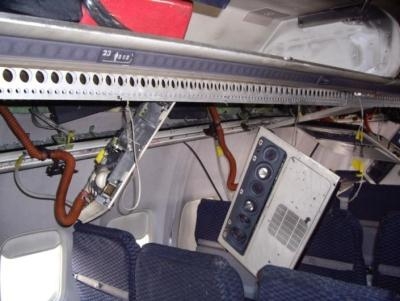Mon, Feb 27, 2012
Bins Separated From The Airplane Ceiling Causing Additional
Injuries, Board Says
The NTSB has issued a series of safety recommendations following
several survivable accidents that have occurred in the last 3 years
in which overhead bins and passenger service units (PSU) on Boeing
737 airplanes became separated from their attachments during the
accident sequences.

The board says in its letter to Acting Administrator Michael
Huerta that the separation of the bins likely increasing the number
of reported occupant injuries, particularly injuries to the head
and face. In addition to this occupant safety hazard, the
negative-g strap attachment bracket (used as part of the flight
crew five-point restraint assembly) failed in two cases, possibly
contributing to back injuries to the flight crewmembers. Findings
in these investigations (some of which are ongoing) suggest that
current crashworthiness test requirements do not provide an
adequate basis on which to evaluate how these items will withstand
impact forces during survivable accidents.
To address the problem, the NTSB says that the FAA should modify
the design and test requirements for the attachment points of
passenger service units to account for the higher localized loading
that results from the relative motion of the attachment structure,
and require that the installation design for overhead bins and
passenger service units (PSU) manufactured by Boeing and installed
in Boeing 737NG series airplanes be modified so that the PSUs
remain attached to the bins or are captured in a safe manner during
survivable accidents.
Overhead Bin Failure NTSB
Image

The agency should also review the designs of manufacturers other
than Boeing for overhead bins and passenger service units (PSU) to
identify designs with deficiencies similar to those identified in
Boeing’s design, and require those manufacturers, as
necessary, to eliminate the potential for PSUs to separate from
their attachments during survivable accidents, and develop test
criteria and performance measures for negative-g strap assemblies
to better evaluate their real-world loading capability during
accident sequences.
Once test criteria and performance measures are established, the
FAA should, amend 14 Code of Federal Regulations Part 25, as
appropriate, to include the newly developed test criteria and
performance measures for negative-g strap assemblies. Finally, the
FAA should require that negative-g strap attachment brackets
manufactured by Ipeco be retrofitted with stronger brackets.
More News
“The rapid succession of contracts indicates that the Chinook will continue to play an important role in the US Army’s family-of-systems, particularly in a contested lo>[...]
Aero Linx: African Business Aviation Association (AfBAA) AfBAA is dedicated to promoting the understanding and advantages of Business Aviation across Africa. Our mission centers on>[...]
Postaccident Examination Revealed That The Right Brake Linings Had Exceeded The Manufacturer’S Serviceable Wear Limit Analysis: The pilot was taxiing from the fixed-base oper>[...]
Also: USAF Pilots, Advanced Aircrew Academy, ATC Hiring, Hop-A-Jet Sues Pan American is attempting a comeback. Aviation merchant bank AVi8 Air Capital, alongside Pan American Globa>[...]
Also: DHS Under Fire, Air New Zealand, ALPA Praises Bipartisan Bill, Spirit Budget Cuts The Minnesota Pilots Association has issued an advisory regarding overflights of the Red Lak>[...]
 Aero-News: Quote of the Day (10.24.25)
Aero-News: Quote of the Day (10.24.25) ANN's Daily Aero-Linx (10.24.25)
ANN's Daily Aero-Linx (10.24.25) NTSB Final Report: Cirrus SR22
NTSB Final Report: Cirrus SR22 Airborne-Flight Training 10.23.25: PanAm Back?, Spirit Cuts, Affordable Expo
Airborne-Flight Training 10.23.25: PanAm Back?, Spirit Cuts, Affordable Expo Airborne 10.22.25: Rez Takes Plane, DJI v US Drone Ban, HK 747 Cargo Accident
Airborne 10.22.25: Rez Takes Plane, DJI v US Drone Ban, HK 747 Cargo Accident




